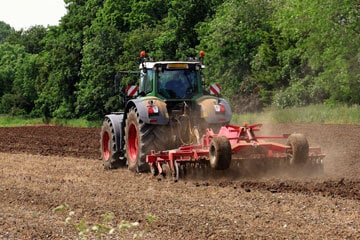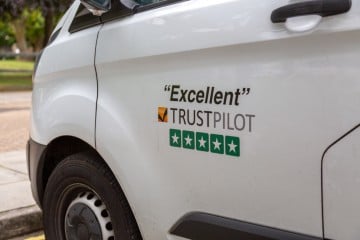If you have a standard driving licence you’re usually entitled to drive a van that weighs up to 3.5 tonnes including cargo and passengers. But as a heads-up, you may need to get a category C or D licence to drive vehicles larger than this.
So, the good news is that you should be able to drive some of the most popular small vans without needing a dedicated van licence.

What vans can I drive with a standard licence?
This generally depends on when you passed your driving test.
If you passed your driving test before 1 January 1997 you should have a C1 entitlement on your licence. This means you can drive a van and trailer combination up to 8,250 kg (8.25 tonnes) maximum authorised mass (MAM).
If you passed your test on or after 1 January 1997, you can drive vehicles up to 3,500 kg (or 3.5 tonnes) MAM. The vehicle can carry a maximum of 8 passengers. You can also tow a trailer with a maximum weight of 750 kg, but the overall weight shouldn’t exceed 3.5 tonnes. You need to take another test to drive anything heavier than this.
Whatever the case may be, some van rental companies require you to be at least 21 in order to hire a van.
MAM is how much the vehicle would weigh on a weighbridge. So it includes:
-
The vehicle weight
-
The driver
-
Any passengers
-
Luggage or cargo
-
Petrol and oil
If you have a category B licence, you can also drive electric vans of up to 4,250 kg (4.25 tonnes). Electric vans are generally heavier than diesels because of the weight of the battery. If you’re driving one of these professionally, you have to take some extra training .
How do I know what type of driving licence I have?
This sounds far more complicated than it actually is! Your licence should list the categories of vehicle you’re allowed to drive. You can find this information on the back of your licence. It should look a bit like this:

You can actually drive a van on a provisional licence, but it shouldn’t weigh over 3.5 tonnes. In addition, you must be accompanied by a full license holder aged 21 or over with at least 3 years of driving experience.
Once you’ve passed your test you can drive a van as long as it doesn’t weigh over 3.5 tonnes. Technically you could drive one at 17 if you’ve passed your test. But if you need to drive one professionally or voluntarily, you need to take an extra test and you might need to be 21 or over.
If you're still not sure what you can drive, you can check your licence at GOV.UK.
What counts as a 3.5 tonne van?
On a standard car licence you can drive these 3.5 tonne vans:
-
Ford Transit
-
Peugeot Boxer
-
Fiat Ducato
-
Renault Master
-
Vauxhall Movano
-
Citroen Relay
A 3.5 tonne van is one that’s allowed to weigh up to 3.5 tonnes when fully laden. The gross vehicle weight (GVW) should be on the vehicle identification number (VIN) plate.
The GVW should include the weight of the van plus the weight of the driver, any passengers and cargo.
You can work out how much the vehicle can hold by taking the GVW minus the kerb weight. The kerb weight is how much the vehicle alone weighs. You can find this:
-
In your owner’s manual
-
On the door sill
-
On the V5 registration document
For example, a 3.5 tonne van with a kerb weight of 1.8 tonnes can carry up to 1.7 tonnes. But then you need to subtract the weight of the driver, passengers and so on.
B1 licences
If you passed your test before January 2013, you should have category B1 on your licence.
If you have a B1 licence, you’re usually allowed to drive smaller vehicles like:
-
Three-wheeled cars
-
Motor tricycles
-
Quad bikes
You can also drive 4-wheeled vehicles weighing up to 400kg, or 550kg if it’s a vehicle designed for carrying goods. These include:
-
Ford Transit Connect
-
Volkswagen Caddy
-
Renault Kangoo
-
Ford Transit
-
Mercedes-Benz Sprinter
-
Volkswagen Crafter
If you passed your test after January 2013, you should have category B on your licence. The difference between a B and B1 licence is that you’re not usually able to drive smaller vehicles, like tricycles on your category B licence. You can drive standard cars and other vehicles up to 3.5 tonnes though.
Category C licences
A category C licence means you can drive medium and larger sized vehicles. If you’re driving professionally, or driving heavier vehicles, you have to take an extra test to get the C category on your licence.
Depending on what training you have, you should get a new licence with these codes on the back:
| Category | Entitlement |
|---|---|
|
C1
|
Vehicles between 3,500kg and 7,500kg MAM with a trailer up to 750kg
|
|
C1E
|
C1 vehicles with a trailer over 750kg. The combined MAM can’t exceed 12,000kg
|
|
C
|
Vehicles over 3,500kg with a trailer up to 750kg
|
|
CE
|
Category C vehicles with a trailer over 750kg
|
How to get a C1 licence
To get a C1 licence you need to have a standard B licence and be 18 or over.
You also need to complete a medical assessment to ensure you don’t have any medical conditions or vision problems.
To get your full C1 licence you then need to pass 3 theory tests and a practical test.
You can find out more about this at GOV.UK.
What licence do I need to drive a HGV?
You need to do your category C test if you want to get a HGV licence.
Say you passed your test after 1997 and wanted to drive a 7.5 tonne HGV. You first need to get a provisional category C1 or HGV licence.
The next step is to complete your Certificate of Professional Competence (CPC). You should be over 18 and already have a full category B licence.
The CPC comes in 4 parts. If you want to drive for a living you need to take all of them.
If you’re not going to get paid for driving, then you only need to take the theory and practical parts of the CPC.
If you passed your test before 1997 your licence should let you drive a 7.5 tonne van. But if you want to drive one for a living you still need to get a CPC.
What licence do I need to drive a minibus, bus or coach?
This depends on what you’re driving and what you plan on doing with the vehicle.
On a standard licence you can drive a minibus or bus that doesn’t weigh over 3.5 tonnes in total, including passengers and cargo. You can't drive a coach on a standard licence.
If you want to drive a minibus, bus or coach for a living, you need to take a dedicated test. Once you’ve passed, you get one of the following codes on your licence:
| Category | Entitlement |
|---|---|
|
D1
|
No more than 16 passenger seats, with a maximum length of 8 metres. Can pull a trailer of up to 750kg
|
|
D1E
|
Any D1 vehicle with a trailer over 750kg MAM. Combined MAM of vehicle and trailer can’t exceed 12,000kg
|
|
D
|
Any bus with more than 8 passenger seats, with a trailer of up to 750kg MAM
|
|
DE
|
Any category D vehicle with trailer weighing more than 750kg MAM
|







